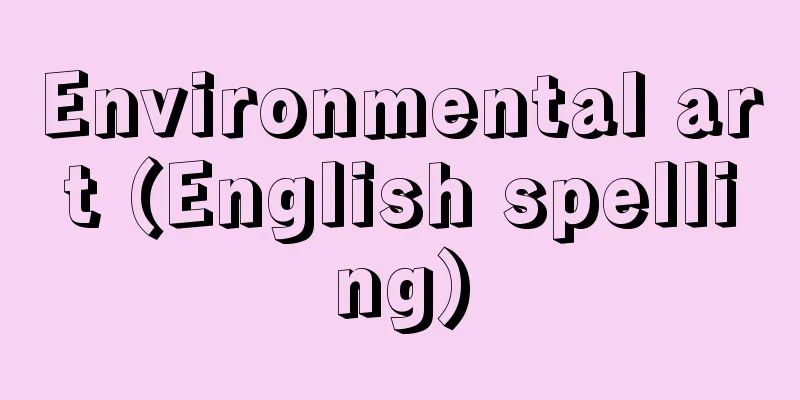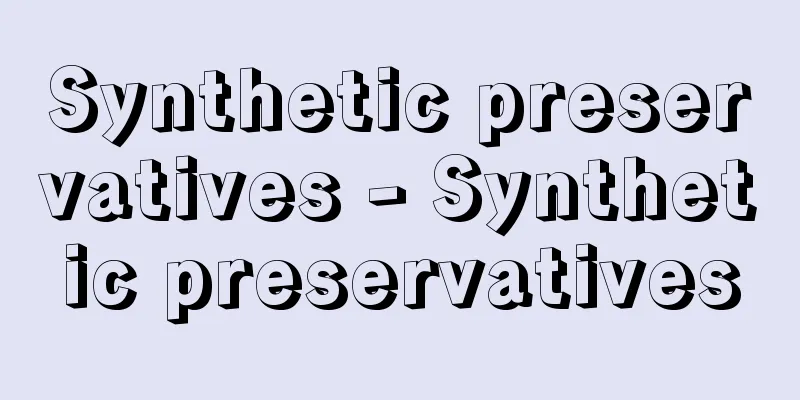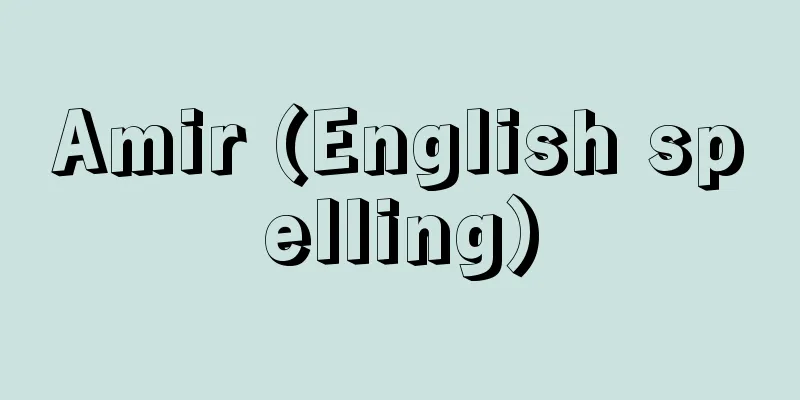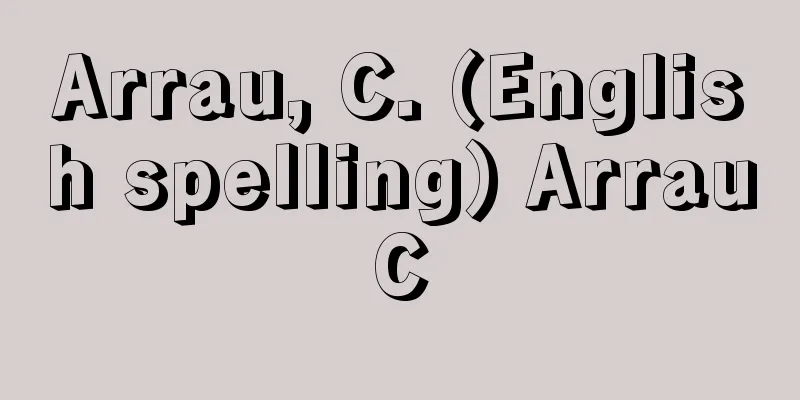Environmental art (English spelling)

|
This refers to artistic works or expressive activities that are developed in relation to the environment. All expressive activities throughout history can be said to be environmental art, but here we will focus on new artistic movements that occurred in the 20th century and divide them into three categories. All of them are related to each other. [Mitamura Shunsuke] Sculpting in the public environmentSince Futurism advocated the liberation of artworks from museums and environmental sculpture, and Constructivists advocated the liberation of visual arts into city centers, this is a movement and policy for adapting artworks to public environments that has been developed around the world. First, in the 1920s, Rivera and Siqueiros promoted the mural movement in Mexico. In 1935, during the Great Depression, President Roosevelt established the Works Progress Administration (WPA) as part of the New Deal policy, which provided artists with the opportunity to decorate public buildings with the aim of rescuing struggling artists and promoting the arts (the Federal Art Program). In the same year, France and Sweden launched a system to allocate 1% of public building costs to art decoration, and after World War II, UNESCO (United Nations Educational, Scientific and Cultural Organization) resolved at its International Congress of Plastic Artists in 1957 that it would be desirable to allocate 2% of building costs to the cost of plastic works. Such public environmental design is part of social and cultural policies, and is not simply added to buildings, but is carried out with the consent of the people as part of an overall environmental plan, as seen in the subway stations in Stockholm in the 1960s and the redevelopment of Paris in the 1980s. In 1981, a gigantic steel sculpture by American artist Richard Serra (1939- ) was installed at Federal Plaza in New York. It led to a lawsuit over its dangers and was removed in 1989, raising questions about the nature of public environmental design. [Mitamura Shunsuke] Design related to the natural environmentThis is a form of artistic activity that has been increasing since the late 1960s, when pollution became an issue and environmental concerns increased. For example, land art and earth works, which are impermanent works that involve lining up stones and trees on the ground, are now commonly known as installations. In Smithson's "Spiral Jetty," the work is swept away by the waves, leaving no trace of the results of the act, only a record. There are also works like Christo's "Packaging the Parliament Building," which go beyond social institutions and require parliamentary approval. Furthermore, works like Walter De Maria (1935-2013), who induces lightning to strike the work, and Turrell's grandiose "Roden Crater" project, in which he dug a tunnel inside an extinct volcano and projected the image of the moon when it is in the southern sky on the wall of the basement using the principle of a pinhole camera, have attracted attention as attempts to incorporate natural phenomena beyond the reach of human beings into art. In 1980, in collaboration with the National Aeronautics and Space Administration (NASA), cosmic art was attempted using artificial satellites. It should be noted that these were often created in remote natural locations rather than in public environments where people gather. There are also movements calling for the protection of the natural environment, such as the "Eco Art" exhibition held in Rio de Janeiro in 1992. [Mitamura Shunsuke] Environmental art as a comprehensive art formIn 1959, American contemporary art organizer Kaprow proposed the idea of environmental art as "art that surrounds the viewer and fills the entire space with all materials, including light, sound, and color." This idea can also be traced back to the activities of the Futurist movement, and can be called a comprehensive art in the sense that it is an artistic expression activity that includes not only sculpture but also one-time, accidental performances using physical expression. There is an increase in more open environmental art, such as the sound and light pageants of synthesizer composer Isao Tomita, which involve the masses, in addition to the arbitrary acts of artists. [Mitamura Shunsuke] Environmental art in JapanIn Japan, where there was no custom of installing sculptures in public spaces, numerous statues of war gods and memorials were made after the Statue of Omura Masujiro (Yasukuni Shrine) was erected in 1893 (Meiji 26) by Okuma Ujihiro (1856-1934). However, many of these were donated and melted down during World War II. After the Second World War, the design of Hiroshima's Peace Bridge was commissioned to Isamu Noguchi, and the wall decoration of the Tokyo Metropolitan Government Building (the old Tokyo Metropolitan Government Building in Marunouchi) to Taro Okamoto, marking the beginning of today's environmental sculpture. Since then, although some municipalities have enacted ordinances on public environmental sculpture, they have not been positioned as part of social or cultural policies, and are currently being promoted as a way to revitalize towns and improve corporate image through sculpture. Some have even been criticized as environmental pollution. As an extension of this, public art such as "Fare Tachikawa," which installed over 100 pieces of art in the city in the 1990s, attracted attention. From the late 1950s, outdoor sculpture exhibitions and sculpture symposiums became popular, and from around 1970, installations became commonplace at sculpture exhibitions, with Kawamata Tadashi's barrack-style architecture and Kuniyasu Takamasa (1957- ), who piled up wood and bricks, known for their large-scale installations. During this time, the Environment Society held the "From Space to Environment" exhibition (Ginza Matsuya, Tokyo) in 1966, which became a catalyst for the excitement of the 1970 Osaka World Expo. Furthermore, environmental art as a comprehensive art form in the sense of considering art including the act can be traced back to the actions of "Mavo" (an avant-garde art group founded in Tokyo in 1923 by Murayama Tomoyoshi and Futurist Art Association members Ogata Kamenosuke and Yanase Masamu) during the Taisho period, and the happenings and events of the "Gutai" group (Gutai Art Association) after World War II. The reality is that performance, which has become a buzzword, is not particularly recognized as environmental art. [Mitamura Shunsuke] "The Horizon of Earthwork: From Environmental Art to Urban Space" by John Bardsley, translated by Toru Mitani (1993, Kajima Publishing Co.) " "Public Art City" by Shoichiro Higuchi (1994, Living Library Publishing Bureau)" "Listening to the Universe: In Search of the Ultimate Environmental Art" by Kazue Mogi (1996, Shunjusha) [References] | | | | | | | | | | | | | | |Source: Shogakukan Encyclopedia Nipponica About Encyclopedia Nipponica Information | Legend |
|
環境とのかかわりにおいて展開される芸術作品あるいは表現活動をいう。歴史上のあらゆる表現活動は環境芸術であるともいえるが、ここでは20世紀におこった新しい芸術の動きに限って三つに分けて述べる。いずれも相互にかかわり合っている。 [三田村畯右] 公共環境における造形未来派(未来主義)が美術館からの作品の解放と環境の彫刻を唱え、構成主義者たちが造形芸術の町なかへの解放を提唱して以来、世界各地で展開されてきた公共環境への造形作品適応のための運動、政策である。 まず、1920年代にはメキシコでリベラやシケイロスらが壁画運動を推進した。アメリカでは大恐慌下の1935年、大統領ルーズベルトがニューディール政策の一環としてWPA(Works Progress Administration、事業促進局)を設置し、困窮した芸術家の救済と芸術振興を目的として公共建築物の装飾に従事する機会を与えた(連邦美術計画)。同じ年、フランスとスウェーデンでは、公共建築費の1%を芸術装飾費とする制度が発足し、第二次世界大戦後はユネスコ(国連教育科学文化機関)でも1957年の国際造形家会議で、建築費の2%を造形作品の費用にあてるのが望ましいと決議している。こうした公共環境造形は、社会・文化政策の一環であり、単に造形物を建築に付加するのではなく、1960年代のストックホルムの地下鉄駅や、1980年代のパリ再開発にみられるように、環境の全体計画のなかで人々の合意のうえで進められるものである。1981年、ニューヨークのフェデラルプラザに設置された、アメリカの造形作家セラRichard Serra(1939― )の鉄による巨大な彫刻が、その危険性をめぐって訴訟にまで発展し、1989年には撤去される事件がおき、公共環境造形のあり方に問題を投げかけた。 [三田村畯右] 自然環境にかかわる造形公害が問題になり環境への関心が高まった1960年代末から増えてきた、自然環境とのかかわりにおいてなされている造形活動である。たとえば、地面に石や木を並べたりするランド・アートやアース・ワークなど恒久的でない造形は、今日ではインスタレーションの名で一般化している。スミッソンの『螺旋(らせん)形の突堤』では、波間にさらわれてその行為の結果は跡かたもなく、記録だけが残されるのである。またクリストの『議事堂の梱包(こんぽう)』のように、国会の承認を得るといった社会制度に踏み込んだものまである。さらに稲妻を誘導して落雷させるデ・マリアWalter De Maria(1935―2013)や、タレルの、死火山の内部にトンネルを掘り、南天した時の月の像を、ピンホール・カメラの原理によって地下室の壁面に映し出そうとする壮大な「ローデン・クレーター」プロジェクトは、人為の及ばない天然現象さえ芸術に取り込もうとする試みとして注目されている。1980年にはアメリカ航空宇宙局(NASA)との共同で、人工衛星を用いたコスミック・アートも試みられた。これらが人の集まる公共環境よりは、人里離れた自然の中で多くなされていることは留意すべきであろう。1992年にリオ・デ・ジャネイロで催された「エコ・アート」展のように、自然環境保護を訴える動きもある。 [三田村畯右] 総合芸術としての環境芸術1959年に、アメリカの現代美術オルガナイザーであるカプローが唱えた「見る者を取り囲み、光、音、色彩を含んだあらゆる素材からなる空間全体を満たす芸術」を環境芸術とする考えである。これもさかのぼれば、未来派の諸活動に起源をみいだすことができ、造形のみならず身体表現による一回性の偶発的なパフォーマンスまでも含む芸術表現活動という意味で、総合芸術といいかえてもよい。恣意(しい)的な芸術家の行為のみならず、シンセサイザー作曲家冨田勲(とみたいさお)の音と光による大衆を巻き込んだページェントなどのように、より開かれた環境芸術も増えている。 [三田村畯右] 日本における環境芸術広場に造形物を設置する習慣のなかった日本では、1893年(明治26)、大熊氏廣(おおくまうじひろ)(1856―1934)によって『大村益次郎像』(靖国(やすくに)神社)が建立されて以降、数多くの顕彰・軍神像がつくられたが、第二次世界大戦中にその多くが供出され鋳(い)つぶされた。 第二次世界大戦後、広島の平和大橋のデザインをイサム・ノグチに、東京都庁舎(丸の内旧都庁舎)の壁面装飾を岡本太郎に委嘱したのが今日の環境造形の始まりである。以後、公共環境造形に関する制度は一部の自治体で条例化されはしたものの、社会・文化政策の一環として位置づけられてはおらず、彫刻による町おこしや企業イメージに役だつものとして進められているのが現状である。なかには環境公害と指摘されるものさえある。その延長上で、1990年代に100余点の作品を街なかに設置した「ファーレ立川」などのパブリック・アートが話題をよんだ。 1950年代後半から野外彫刻展や彫刻シンポジウムなどが盛んになり、1970年ごろからは彫刻展でもインスタレーションが一般化し、バラック建築風の川俣正(かわまたただし)、木材と煉瓦(れんが)を積み上げる國安孝昌(たかまさ)(1957― )らが大がかりな展開で知られている。この間、1966年にはエンバイラメントの会による「空間から環境へ」展(東京・銀座松屋)が催され、70年大阪万国博覧会での高揚への契機となった。 なお、行為までも含めて芸術を考えるという意味での総合芸術としての環境芸術は、大正期に前衛芸術としての「マヴォ」(1923年に村山知義(ともよし)と未来派美術協会のメンバーであった尾形亀之助(かめのすけ)、柳瀬正夢(やなせまさむ)らにより東京で発足した前衛美術グループ)のアクション、第二次世界大戦後の「具体」グループ(具体美術協会)のハプニング、イベントにその系譜をみいだせる。流行語ともなっているパフォーマンスは、格別に環境芸術という認識で行われているのでもないのが実情であろう。 [三田村畯右] 『ジョン・バーズレイ著、三谷徹訳『アースワークの地平 環境芸術から都市空間まで』(1993・鹿島出版会)』▽『樋口正一郎著『パブリック・アート都市』(1994・住まいの図書館出版局)』▽『茂木一衛著『宇宙を聴く 究極の環境芸術をもとめて』(1996・春秋社)』 [参照項目] | | | | | | | | | | | | | | |出典 小学館 日本大百科全書(ニッポニカ)日本大百科全書(ニッポニカ)について 情報 | 凡例 |
>>: Basic Law on the Environment
Recommend
Kanji Kato
An agrarianist and leader in peasant education an...
Strawberry white
…The Shojin Kenritsū (1819-24) lists more than 10...
Reproduction - Kiyozuri
A printing term referring to the special printing ...
Functional heart murmurs
A functional heart murmur is a noise that can be ...
Vir
…Abbreviation: Vir. One of the twelve zodiacal si...
Preferential ear - Kikimimi
...In such a situation, only the right or the lef...
Nanetsu - Nanetsu
Zhao Tuo, a military commander from Hebei Zhendin...
Beneš, Edvard
Born: May 28, 1884 in Kozlany, Austria-Hungary Die...
"Alexander's Campaign"
…the appendix to the work Alexander the Great'...
Hell - Naraku
It means hell. It is a transliteration of the San...
disturbance of thought
…In this way, the functional connection from the ...
Abandoned - abandoned
Abandonment refers to the neglect of custody duti...
terra roxa (English spelling) terraroxa
...The brown soil derived from carbonate rocks is...
Culex tritaeniorhynchus (English notation) Culex tritaeniorhynchus
… [Takeshi Kurihara]. … *Some of the terminology ...
Ashimmaru - Kuma Wakamaru
Son of Hino Suketomo. His name was Kunimitsu. At t...









